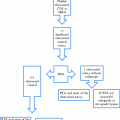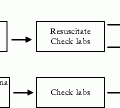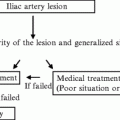Risk Factor
Grade
Complication
Diabetes
0
1
2
3
None
Adult onset, diet controlled
Adult onset, insulin controlled
Juvenile onset
Tobacco usea
0
1
2
3
Never or none for last 10 years
None current, but smoked in last 10 years
Less than 1 pack/dayb
Greater than 1 pack/day
Hypertension
0
1
2
3
Nonec
Easily controlled with single drug
Controlled with two drugs
Requires more than 2 drugs or uncontrolled
Hyperlipidemia
0
1
2
3
Cholesterol/triglycerides within normal limits for age
Mild elevation, controlled by diet
Types II, III, IV requiring strict diet control
Requiring diet and drug control
Cardiac Status
0
1
2
3
Asymptomatic, normal ECG
Asymptomatic, h/o MI _6 mo, or occult MI by ECG
Stable angina, controlled ectopy, or asymptomatic
arrhythmia, drug compensated CHF
Unstable angina, symptomatic or poorly controlled
ectopy/arrhythmia, poorly compensated CHF, MI
within 6 months
Carotid Disease
0
1
2
3
No symptoms, bruit, or evidence of diseased
Asymptomatic but evidence of disease
Transient or temporary stroke
Completed stroke with permanent neurologic deficit
Renal Status
0
1
2
3
No known renal disease, serum creatinine _1.5 mg/dL, creatinine clearance _50 mL/min
Serum creatinine 1.5–3.0 mg/dL, creatinine clearance 30–50 mL/min
Serum creatinine 3.0–6.0 mg/dL, creatinine clearance 15–30 mL/min
Serum creatinine _6.0 mg/dL, creatinine clearance _15 mL/min, or on dialysis or with transplant
Pulmonary Status
0
1
2
3
Asymptomatic, normal CXR, PFT 20% of predicted
Asymptomatic or mild dyspnea on exertion, mild
CXR parenchymal changes, PFT 65–80% of predicted
Between 1 and 3
PFT: VC _1.85, FEV1 _1.2 L or _35% of predicted
Max. Vol. ventilation _28 L/min or _50% of
predicted, PCO2 _45 mm Hg, supplementary
oxygen needed, pulmonary hypertension
Table 3.2
Classification of complications by outcome
Minor complications |
•No therapy, no sequela |
•Minor therapy or minor sequela, includes unplanned overnight hospital admission for observation only (<24 h) |
Major complications |
•Requires major therapy or unplanned hospitalization (24–48 h) |
•Requires major therapy, unplanned increase in the level of care, prolonged hospitalization (>48 h) |
•Permanent adverse sequela |
•Death |
Table 3.3
Clinical categories of acute limb ischemia
Category | Findings | Doppler signals | |||
|---|---|---|---|---|---|
Description | Sensory loss | Muscle weakness | Arterial | Venous | |
I. Viable | Not immediately threatened | None | None | Audible | Audible |
II. Threatened | |||||
(a) marginal | Salvageable if promptly treated | Minimal (toe) or none | None | Often inaudible | Audible |
(b) immediately | Salvageable with immediate revascularization | More than toes, associated with rest pain | Mild, moderate | Usually inaudible | Audible |
III. Irreversiblea | Major tissue loss or permanent nerve damage Inevitable | Profound, anesthetic | Profound, paralysis (rigor) | Inaudible | Inaudible |
Table 3.4
Clinical categories of chronic limb ischemia
Grade | Category | Clinical description | Objective criteria |
|---|---|---|---|
0 | 0 | Asymptomatic, no hemodynamically significant occlusive disease | Normal results of treadmill*/stress |
I | 1 | Mild claudication | Treadmill exercise completed, postexercise AP is greater than 50 mm Hg but more than 25 mm Hg less than normal |
2 | Moderate claudication | Symptoms between those of categories 1 and 3 | |
3 | Severe claudication | Treadmill exercise cannot be completed, postexercise Ap is less than 50 mm Hg | |
II | 4 | Ischemic rest pain | Resting AP of 40 mm Hg or less, flat or barely pulsatile ankle or metatarsal plethysmographic tracing, toe pressure less than 30 mm Hg |
III | 5 | Minor tissue loss, nonhealing ulcer, focal gangrene with diffuse pedal ischemia | Resting AP of 60 mm Hg or less, ankle or metatarsal plethysmographic tracing flat or barely pulsatile, toe pressure less than 40 mm Hg |
6 | Major tissue loss, extending above transmetatarsal level, functional foot no longer salvageable | Same as for category 5 |
Table 3.5
Definitions of success for endoluminal revascularization devices
I.Technical: Meets the criteria for both anatomic and homodynamic success in the immediate post-procedure periods |
A.Anatomic: <30% final residual stenosis measured at the narrowest point of the vascular lumen Continued anatomic: < 50% recurrent stenosis |
B.Hemodynamic: ABI or thigh/brachial index improved by 1.0 or greater above baseline and not deteriorated by >0.15 from the maximum early post-procedure level, or pulse volume recording distal to the reconstruction maintained at 5 mm above the preoperative tracing (only for patients with incompressible vessels) |
II.Clinical: Immediate improvement by at least 1 clinical category, sustained improvement by at least 1 clinical category, patients with tissue loss (categories 5 and 6) must move up at least 2 categories and reach the level of claudication to be considered improved |
Table 3.6
Definitions of improvement of lower limb arterial diseases
Grade | Definition |
|---|---|
+3 | Markedly improved. Symptoms are gone or markedly improved. ABI increased to >0.90 |
+2 | Moderately improved. Still symptomatic but with improvement in lesion category.a ABI increased by >0.10 but not normalized |
+1 | Minimally improved. Categorical improvement in symptoms without significant ABI increase (0.10 or less) or vice versa (but not both) |
0 | No change. No categorical shift and less than 0.10 changes in ABI |
−1 | Mildly worse. Either worsening of symptoms or decrease in ABI of >0.10 |
−2 | Moderate worsening. Deterioration of the patient’s condition by one category or unexpected minor amputation |
−3 | Marked worsening. Deterioration of the patient’s condition by more than one category or major amputation |
Table 3.7
Reporting requirements and recommendations for endoluminal revascularization devices
Data | Required | Highly recommended | Recommended |
|---|---|---|---|
Pretreatment evaluationa | |||
Risk factors/Comorbidities | X | ||
Measures of disease severity | |||
Stenosis of treated site | X | ||
Runoff grade | X | ||
Eccentricity | X | ||
Noninvasive indices (ABI, TBI, PVR) | X | ||
Treadmill (claudicants) | X | ||
graded treadmill | X | ||
Functional status | X | ||
Quality of life | X | ||
Treatment description | X | ||
Posttreatment evaluationa | |||
Follow-up angiogram | X | ||
Technical success | |||
Anatomic | |||
Stenosis | X | ||
Luminal gain | X | ||
Hemodynamic | |||
Noninvasive (ABI, TBI, PVR) | X | ||
intravascular pressures | X | ||
Clinical success | |||
Improvement category | X | ||
Functional status | X | ||
Quality of life | X | ||
Treadmill (claudicants) | X |
||








